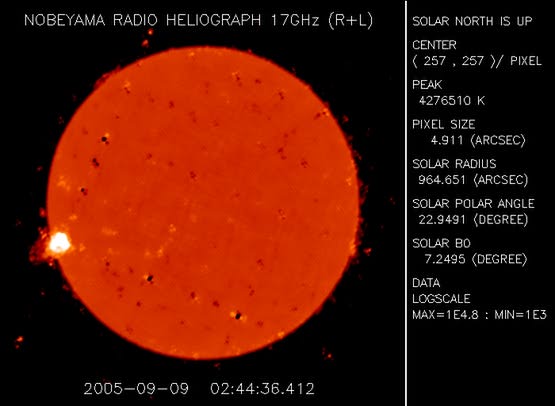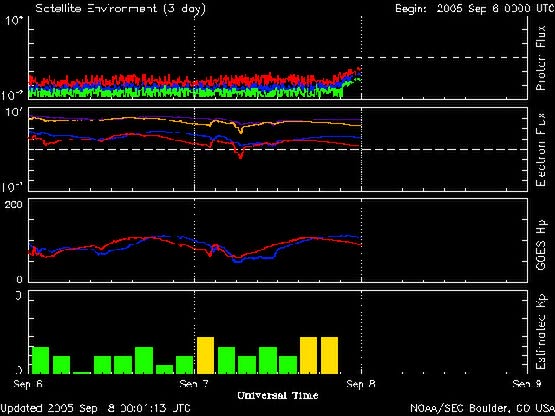- Our sun currently has produced an on-going massive X-Ray
flare. What are the effects of a massive burst of energy like this]? In
this article, we shall explore this flare from several angles and the impact
it will have on everyone.
-
- Here are a few of the negative effects:
-
- 1. High speed gamma particles impact the ionosphere and
can severely interfere with communications.
-
- 2. Satellites can be disabled or permanently damaged
if the energy level is high enough to exceed acceptable design limits.
Design limits are based on past solar history.
-
- 3. X-ray energy of this magnitude can be deadly to any
astronauts in unshielded spacecraft.
-
- 4. An intense flare can disrupt satellite communications.
This will effect long distance telephone, radio and television networks
and data links such as the internet.
-
- 5. Insulators on high tension power lines are have convoluted
surfaces, which appear as ribs. This lengthens the effective distance from
the power line to the tower, by using this zig-zag pattern. If the atmosphere
is highly ionized, it shortens this zig-zag pattern by creating a straight
line of ionized conductive air over the outside of the insulator. This
causes the power line insulators to electrically arc to the grounded steel
tower arm. This is a classic "short circuit." The arcing immediately
trips circuit breakers, which cannot be reset until the ionization subsides.
When this happened in Quebec back in the 90's power was out for five days.
It was known to be directly caused by a coronal mass ejection from the
sun, which struck the earth over that part of Canada.
-
- WHAT CAN SATELLITES SHOW?
-
- There are five main wavelengths which the NOAA GOES satellites
monitor. Periodically these imaging sensors require a "bake-out."
This requires the sensors to be shutdown, followed by raising the the CCD
sensor chip's temperature using the sun's radiant heat. This "cleans
out" the sensor by boiling off unwanted charged particles that add
noise to images, and takes several days to complete.
-
- Unfortunately, such a bakeout is now underway so we cannot
see all the sun's wavelengths with normal GOES images. All except for one
wavelength that is.
-
- There is still an X-ray sensor still operating on one
satellite. Normally even with an active sun, this sensor image is very
dark green (see untouched image below from NOAA, taken on August 25th 2005.)
There appears to be a raised hexagonal pattern. This appeared about two
weeks ago - and is at the very same latitude as today's massive flare.
A hexagon shape is also visible in the lower image as a faint dark outline
near the right horizon, and it may be the same one. The way these structures
form is unknown.
-
-
-

-
-
-
- The VERY bright, intense flare which has erupted is shown
below. It's not aimed at earth ...yet:
-
-

-
-
-
- IMPACT ON LIFE
-
- Now the question remains - what impact will this flare
have on people if it comes our way? Without question, it will force the
astronauts to remain in one of the safe areas onboard the space station.
Deadly high energy gamma rays pass through the station as though it isn't
even there. Shielded areas on the station provide some measure of protection
to astronauts, who can do little but wait out the flare's passing. NASA
has not said if the astronauts will receive a cancer-causing dose or lethal
dose if this flare erupts toward earth and subsequently, the space station.
-
- Here on earth, our health may not be affected since we
are well protected by the earth's magnetic field. It captures high speed
particles and holds them out in space around the earth, like fly paper
does to flies.
-
- EMERGENCY RADIO BLACKOUTS AND JAMMING
-
- What is the official opinion? From the US government
(NOAA) we read their following statement about the image shown above:
-
- [begin extract]
-
- The very active Region 808 produced a powerful X-17 flare
(R4, severe radio blackout, on the NOAA
space weather scales), which was observed on the NOAA
GOES satellite. "This flare, the fourth largest in the last 15
years, erupted just as the Region 808 sunspot cluster was rotating onto
the visible disk of the sun," said Larry Combs, solar forecaster at
the NOAA Space Environment Center. Intense radio emissions were also associated
with this flare. A very bright and fast coronal mass ejection was observed
on coronagraph imagery. However, the material was not Earth directed. Over
the past two weeks, this active region has produced a series of significant
solar eruptions as it made its passage around the back side of the sun
with minor impacts.
-
- "This event created a complete blackout of high
frequency communications on the daylit side of Earth, which included the
entire U.S. and basically anywhere the sun was shinning at this time,"
said Combs. "Communications used by emergency services along the Gulf
Coast may have experienced problems due to this flare. Low frequency navigation
systems may also have experienced a period of significant degradation,"
he added.
-
- [end extract]
-
- Note the above comment - "This event created a complete
blackout of high frequency communications on the daylit side of Earth."
One cannot underestimate the importance of this - especially since the
flare was NOT aimed at the earth when it erupted. The comment about "intense
radio emissions" translates essentially to jamming communications.
-
- What is so important about this flare, is that it wasn't
aimed at us...yet.
-
- Another area often misunderstood by the public, is that
of geomagnetic storms. I've included a chart below from NOAA that accurately
describes what these are and how they are measured. Keep in mind however
as you read this, that supposedly we have passed the peak of the 11 year
cycle - a period which historically is a calm sun. However, this has not
been the case in this cycle. No one knows why the sun have been so incredibly
active over the past few years. If they do know, they are not telling us.
-
- NOAA Space Weather Scale for Geomagnetic Storms
-
- Category
-
- Effect
-
- Physical measure
-
- Average Frequency
- (1 cycle = 11 years)
-
- Scale
-
- Descriptor
-
- Duration of event will influence severity of effects
-
-
- Geomagnetic Storms
-
- Kp values*
- determined every 3 hours Number of storm events when
Kp level was met;
- (number of storm days)
-
- G 5
-
- Extreme
-
- Power systems: : widespread voltage control problems
and protective system problems can occur, some grid systems may experience
complete collapse or blackouts. Transformers may experience damage.
-
- Spacecraft operations: may experience extensive surface
charging, problems with orientation, uplink/downlink and tracking satellites.
-
- Other systems: pipeline currents can reach hundreds of
amps, HF (high frequency) radio propagation may be impossible in many areas
for one to two days, satellite navigation may be degraded for days, low-frequency
radio navigation can be out for hours, and aurora has been seen as low
as Florida and southern Texas (typically 40? geomagnetic lat.)**.
-
- Kp = 9
-
- 4 per cycle
- (4 days per cycle)
-
- G 4
-
- Severe
-
- Power systems: possible widespread voltage control problems
and some protective systems will mistakenly trip out key assets from the
grid.
-
- Spacecraft operations: may experience surface charging
and tracking problems, corrections may be needed for orientation problems.
-
- Other systems: induced pipeline currents affect preventive
measures, HF radio propagation sporadic, satellite navigation degraded
for hours, low-frequency radio navigation disrupted, and aurora has been
seen as low as Alabama and northern California (typically 45? geomagnetic
lat.)**.
-
- Kp = 8, including a 9-
-
- 100 per cycle
- (60 days per cycle)
-
- G 3
-
- Strong
-
- Power systems: voltage corrections may be required, false
alarms triggered on some protection devices.
-
- Spacecraft operations: surface charging may occur on
satellite components, drag may increase on low-Earth-orbit satellites,
and corrections may be needed for orientation problems.
-
- Other systems: intermittent satellite navigation and
low-frequency radio navigation problems may occur, HF radio may be intermittent,
and aurora has been seen as low as Illinois and Oregon (typically 50? geomagnetic
lat.)**.
-
- Kp = 7
-
- 200 per cycle
- (130 days per cycle)
-
- G 2
-
- Moderate
-
- Power systems: high-latitude power systems may experience
voltage alarms, long-duration storms may cause transformer damage.
-
- Spacecraft operations: corrective actions to orientation
may be required by ground control; possible changes in drag affect orbit
predictions.
-
- Other systems: HF radio propagation can fade at higher
latitudes, and aurora has been seen as low as New York and Idaho (typically
55? geomagnetic lat.)**.
-
- Kp = 6
-
- 600 per cycle
- (360 days per cycle)
-
- G 1
-
- Minor
-
- Power systems: weak power grid fluctuations can occur.
-
- Spacecraft operations: minor impact on satellite operations
possible.
-
- Other systems: migratory animals are affected at this
and higher levels; aurora is commonly visible at high latitudes (northern
Michigan and Maine)**.
-
- Kp = 5
-
- 1700 per cycle
- (900 days per cycle)
-
- * The K-index used to generate these messages are derived
in real-time from the Boulder
NOAA Magnetometer. The Boulder K-index, in most cases, approximates
the Planetary Kp-index referenced in the NOAA Space Weather Scales. The
Planetary Kp-index is not available in real-time.
- ** For specific locations around the globe, use geomagnetic
latitude to determine likely sightings (Tips
on Viewing the Aurora)
-
- ******************************
-
- One can also use the Kp index to approximately determine
how far south of the north pole an aurora may be seen. The higher the Kp
value, the farther south it will be visible. It has the appearance as waves
of faint pink light that sweep across the sky in the northern part of the
lower 48 states. Auroral light is so faint in the United States that any
other light such as the moon, town or city light pollution will usually
make the aurora invisible.
-
- It would be prudent for anyone requiring critical use
of a radio or other similar wireless communications in the next week or
so to consider using another form of communication. Or if possible, postpone
such an event until the flare has passed. Unfortunately police, fire and
the armed forces require heavy use of radios to do their work.
-
- For Ham operators, the flare might help shortwave transmissions
by increasing ionization of the ionosphere. And hence, improve the skip
factor. Ionization can help make the ionosphere behave more like a mirror,
and improve radio performance at lower frequencies. It can also have the
opposite effect for higher frequency transmissions, such as HF or higher
wavelengths. This could be especially true if the sun's radio emissions
happen to be at a frequency required for communications.
-
- Below: Flare imaged at 17GHz taken in Japan.
-
-

-
-
-
- Other than the flare, there are also evenly spaced features.
These features are most likely not created on earth, since these do not
quite form a grid pattern.
-
-
-

-
-
- In the image above, we can see that 10Mev (Million electron
volt), 50 Mev and 100Mev levels are now rising at the location of the satellite
making the measurement. This also is taking place at the space station.
-
- Ted Twietmeyer
-
- www.data4science.net
-
|